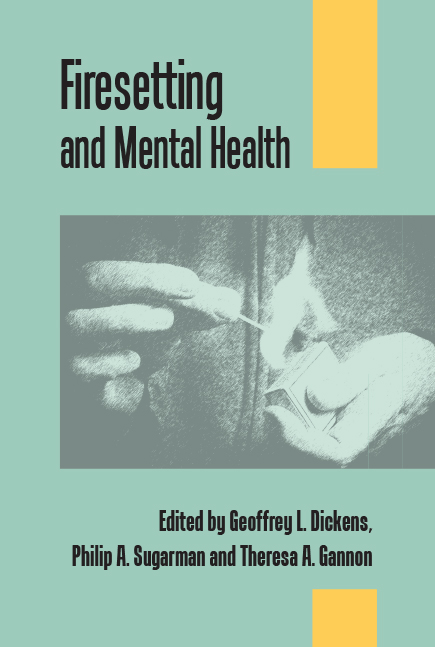Book contents
- Frontmatter
- Contents
- List of figures, tables and boxes
- List of contributors
- Preface
- Part I Theory and research
- Part II Practice and law
- 9 Legal perspectives on arson
- 10 Assessment of firesetters
- 11 Bushfire and wildfire arson: arson risk assessment in the Australian context
- 12 Arson: treatment and interventions
- 13 Arson and mental health: case reports from psychiatric practice
- 14 Fire risk and fire safety in psychiatric care
- Index
10 - Assessment of firesetters
from Part II - Practice and law
- Frontmatter
- Contents
- List of figures, tables and boxes
- List of contributors
- Preface
- Part I Theory and research
- Part II Practice and law
- 9 Legal perspectives on arson
- 10 Assessment of firesetters
- 11 Bushfire and wildfire arson: arson risk assessment in the Australian context
- 12 Arson: treatment and interventions
- 13 Arson and mental health: case reports from psychiatric practice
- 14 Fire risk and fire safety in psychiatric care
- Index
Summary
This chapter will equip readers with the information required to screen and assess arsonists effectively using a number of modalities. The appropriate tools are presented and discussed, along with the evidence base underlying them. The focus of the discussion is on risk assessment, recidivism and dangerousness. In particular, these issues are discussed with reference to mental health and psychiatric patients as arsonists. The terms ‘arson’ and ‘firesetting’ will be used interchangeably throughout this chapter; the term ‘arson’ is commonly acknowledged to have a legal definition, while firesetting describes the behaviour itself.
The process of assessing firesetters is tricky but perhaps not for the reason one might think initially. Firesetters are not especially distinct across many variables when compared with other types of offender. While they share more commonalities with property offenders than with violent offenders (Quinsey et al, 2006), the typical profile of an arsonist reveals a similar pattern of social and economic disadvantage to most criminals (Hurley & Monahan, 1969; Tennent et al, 1971; O'sullivan & Kelleher, 1987; Barnett & Spitzer, 1994; Puri et al, 1995). However, unlike with some other types of offender (notably sex and violent offenders), the psychology of arsonists has not been the subject of extensive exploration, although interest is certainly growing. One of the consequences of this lack of attention is that arson-specific assessment protocols have not yet been fully developed. Work is progressing it seems more rapidly in the area of juvenile assessment (McEwan et al, in press; Fritzon et al, 2011) than in adult assessment (Gannon & Pina, 2010), but there remains a lack of empirical testing of any proposed protocols. The general principles of forensic mental health assessments are adequately addressed elsewhere (see Heilbrun et al, 2009). Accordingly, this chapter addresses those instruments currently available which may be useful for arson risk assessment. A key focus of the discussion is on exploring for inclusion in assessments aspects of risk of arson recidivism and level of harm, as well as issues relevant for assessing arsonists before treatment.
The chapter makes some of the same assumptions that have been criticised elsewhere. Specifically, in discussing the issue of assessment of firesetters we are treating the population as a homogeneous group.
- Type
- Chapter
- Information
- Firesetting and Mental Health , pp. 184 - 205Publisher: Royal College of PsychiatristsFirst published in: 2017

